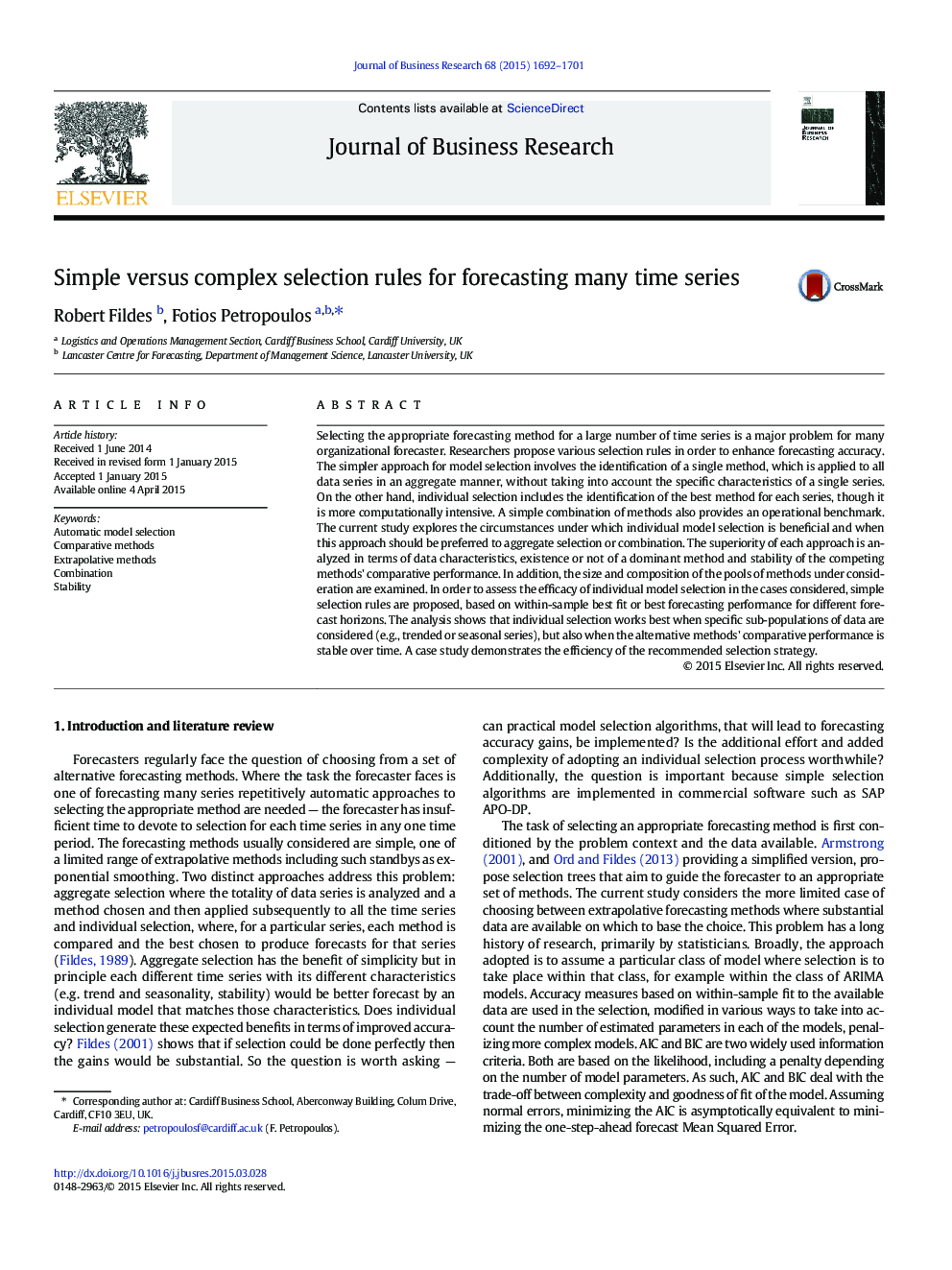| کد مقاله | کد نشریه | سال انتشار | مقاله انگلیسی | نسخه تمام متن |
|---|---|---|---|---|
| 10492977 | 940288 | 2015 | 10 صفحه PDF | دانلود رایگان |
عنوان انگلیسی مقاله ISI
Simple versus complex selection rules for forecasting many time series
ترجمه فارسی عنوان
ساده در مقابل قوانین پیچیده انتخاب برای پیش بینی بسیاری از سری زمان
دانلود مقاله + سفارش ترجمه
دانلود مقاله ISI انگلیسی
رایگان برای ایرانیان
کلمات کلیدی
ترجمه چکیده
انتخاب روش پیش بینی مناسب برای تعداد زیادی از سری زمانی یک مشکل عمده برای بسیاری از پیش بینی سازمانی است. محققان پیشنهاد می کنند که قوانین گوناگونی را انتخاب کنند تا دقت پیش بینی را افزایش دهند. رویکرد ساده تر برای انتخاب مدل شامل شناسایی یک روش واحد است که به طور کلی به تمام سری داده ها اعمال می شود بدون توجه به ویژگی های خاص یک سری واحد. از سوی دیگر، انتخاب فردی شامل شناسایی بهترین روش برای هر سری است، هرچند که بیشتر در محاسبات فشرده است. ترکیبی ساده از روش ها همچنین یک معیار عملیاتی را فراهم می کند. در حال حاضر مطالعه مورد بررسی شرایطی است که انتخاب مدل فردی مفید است و زمانی که این رویکرد باید ترجیح داده شود تا انتخاب یا ترکیب ترکیبی مورد نظر باشد. برتری هر رویکرد از نظر ویژگی های داده، وجود یا عدم استفاده از روش غالب و ثبات عملکرد مقایسه ای روش های رقابت، تحلیل می شود. علاوه بر این، اندازه و ترکیب مجموعه های روش های مورد بررسی مورد بررسی قرار می گیرد. برای ارزیابی اثربخشی انتخاب مدل فرد در موارد مورد نظر، قوانین انتخاب ساده بر اساس بهترین عملکرد مناسب یا بهترین پیش بینی درون نمونه برای افق های پیش بینی های مختلف ارائه می شود. تجزیه و تحلیل نشان می دهد که انتخاب فردی بهترین کار زمانی است که زیر مجموعه های داده های خاص در نظر گرفته می شود (به عنوان مثال، سری های روند یا فصلی)، بلکه زمانی که عملکرد مقایسه ای روش های مداوم در طول زمان پایدار می باشد. مطالعه موردی نشان دهنده کارآیی استراتژی انتخاب پیشنهاد شده است.
موضوعات مرتبط
علوم انسانی و اجتماعی
مدیریت، کسب و کار و حسابداری
کسب و کار و مدیریت بین المللی
چکیده انگلیسی
Selecting the appropriate forecasting method for a large number of time series is a major problem for many organizational forecaster. Researchers propose various selection rules in order to enhance forecasting accuracy. The simpler approach for model selection involves the identification of a single method, which is applied to all data series in an aggregate manner, without taking into account the specific characteristics of a single series. On the other hand, individual selection includes the identification of the best method for each series, though it is more computationally intensive. A simple combination of methods also provides an operational benchmark. The current study explores the circumstances under which individual model selection is beneficial and when this approach should be preferred to aggregate selection or combination. The superiority of each approach is analyzed in terms of data characteristics, existence or not of a dominant method and stability of the competing methods' comparative performance. In addition, the size and composition of the pools of methods under consideration are examined. In order to assess the efficacy of individual model selection in the cases considered, simple selection rules are proposed, based on within-sample best fit or best forecasting performance for different forecast horizons. The analysis shows that individual selection works best when specific sub-populations of data are considered (e.g., trended or seasonal series), but also when the alternative methods' comparative performance is stable over time. A case study demonstrates the efficiency of the recommended selection strategy.
ناشر
Database: Elsevier - ScienceDirect (ساینس دایرکت)
Journal: Journal of Business Research - Volume 68, Issue 8, August 2015, Pages 1692-1701
Journal: Journal of Business Research - Volume 68, Issue 8, August 2015, Pages 1692-1701
نویسندگان
Robert Fildes, Fotios Petropoulos,
